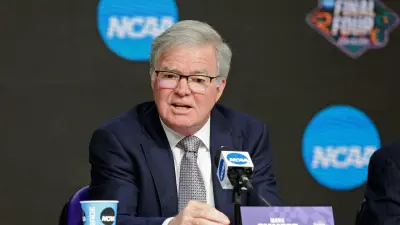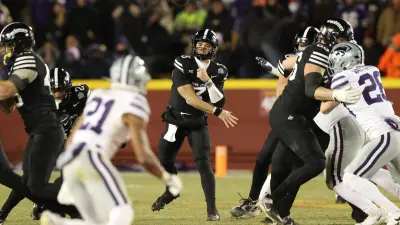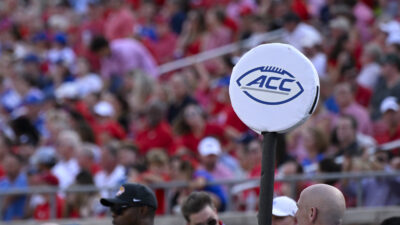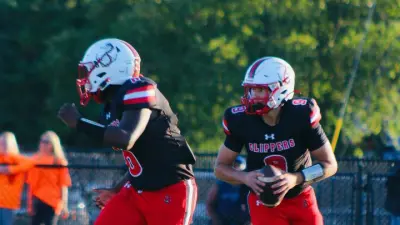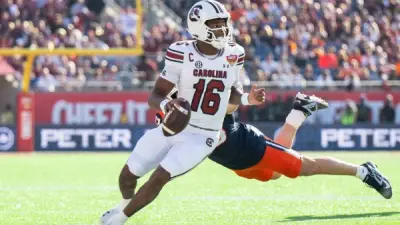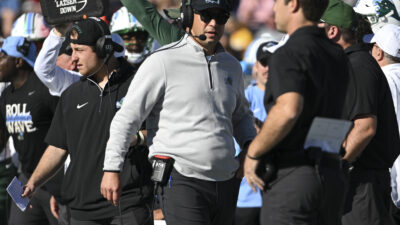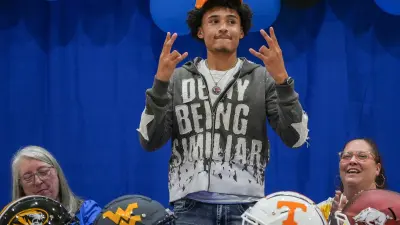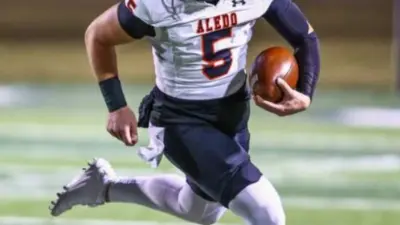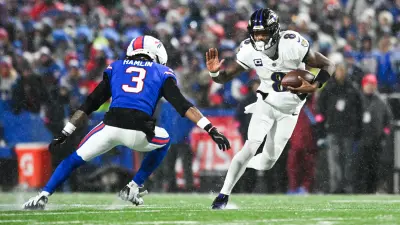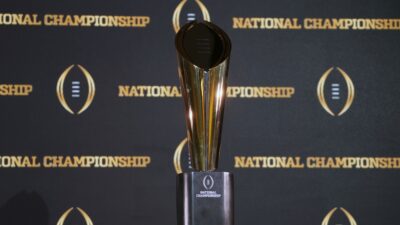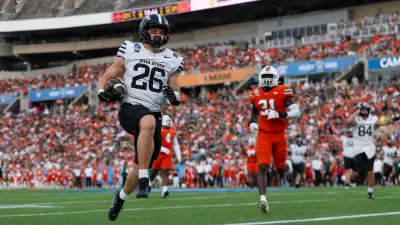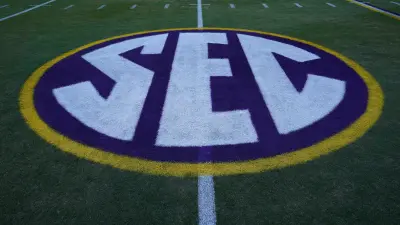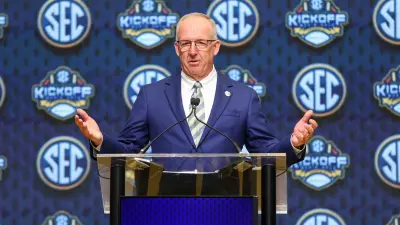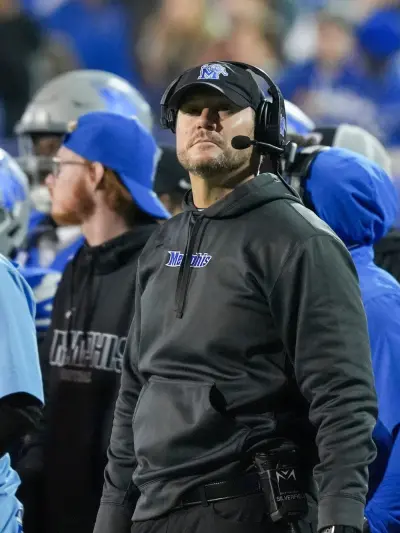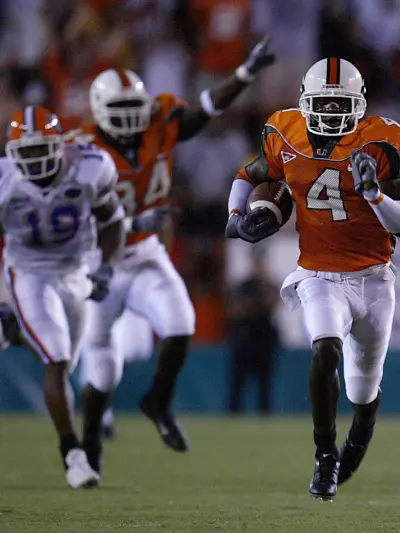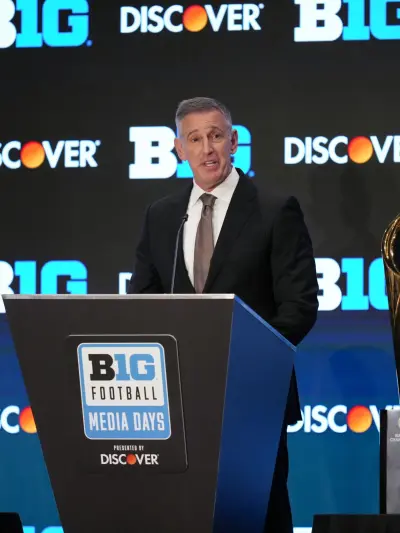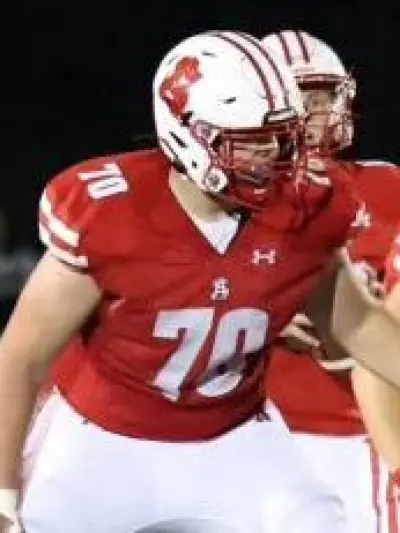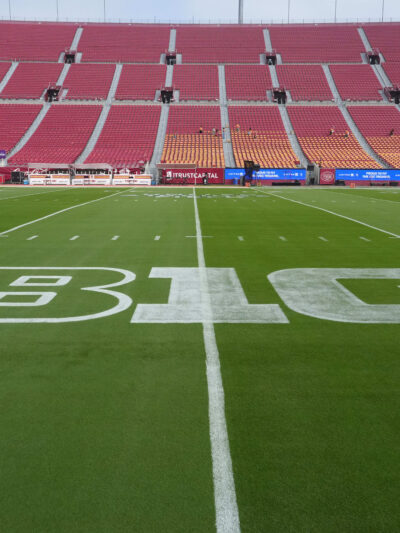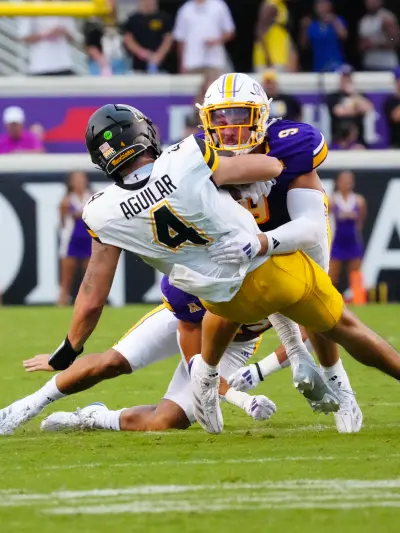When Kevin Warren accepted the position of becoming the next President and CEO of the Chicago Bears, it was a culminating shockwave to what was a very up-and-down tenure as Big Ten commissioner.
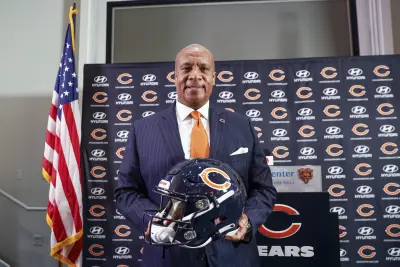
Warren began his term as commissioner with the COVID-19 pandemic raging across the planet, and he made his first big waves by shutting down Big Ten football for the 2020 season. Eventually, Warren would have a change of opinion and the league would play, but his seismic decision would be the first of many that would shape or reshape college football.
Arguably, the biggest tsunami for Warren was luring Southern California and UCLA to the Big Ten. According to The Oklahoman, had Warren gotten his way, the Big Ten would have continued its cannibalization of the Pac-12 but adding Stanford, Cal, Oregon, and Washington. The Big Ten presidents opposed this move.
With the current climate in college football of expansion, media rights deals, NIL (Name, Image, Likeness), coaching changes, transfer portal, amongst others, Warren felt it was time to exit stage left.
“I just felt in 40 months there for us to be able to come in and handle the pandemic in a matter that I thought kept our student-athletes healthy and safe, for us to be a leader in social justice initiatives, for us to be a leader in the mental health space, for us to be able to set records from at television network creativity standpoint and to be able to expand with USC and UCLA, I would say I left the Big Ten in a demonstratively better position,” said Warren in his introductory press conference with the Bears.
While Warren feels he left the Big Ten in a better position, the sport as a whole isn’t in a better position. Currentlym we see coaches who are alleging widespread tampering, notably Pitt head coach Pat Narduzzi with Jordan Addison transfer a season ago and recently involving with University of North Carolina quarterback Drake Maye being offered money to transfer.
More Sports News
It is a situation where there is no honor amongst thieves. Reviewing quarterback Jaden Rashada’s situation with Florida, the University granted the release of Rashada from his signed letter of intent after a fall out between Rashada and the Gator NIL collective had a severe disagreement. From what has been reported by ESPN, Rashada agreed to sign with Florida during the early signing period. In return for his pledge, Rashada would be able to collect $13 million in NIL opportunities. After that deal couldn’t be made, Rashada wanted out.
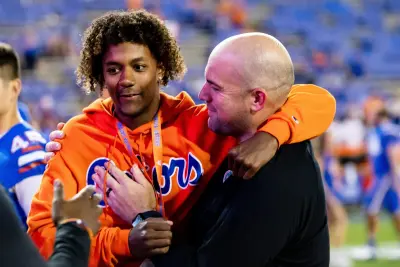
Beyond the alleged tampering and the new frontier of collectives and NIL, you have the transfer portal. The transfer portal has been a combination of a blessing and a curse for college football programs across the nation. The sport still deals with many other issues with expansion and realignment conversations, coaches bailing before bowl games, opt outs in bowl games, coaching contracts, and many other issues, but how did college football get to this unique time of array?
Where it All Started
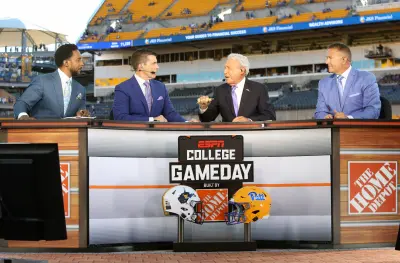
When you begin to look at the current landscape of college football, the roots of the situation dates back to the 1984 Supreme Court Ruling in the NCAA vs. Board of Regents of the University of Oklahoma.
Leading up to that landmark court case, college football seemed to enter a golden age in the 1970’s on television. There were regional powers through the country with Penn State in the northeast, Alabama in the southeast, Ohio State and Michigan dueled in the midwest in the Big Ten while Notre Dame was a national power under Ara Parseghian and Dan Devine, Oklahoma and Nebraska in the great plains, Texas schools along with Arkansas squared off in the Southwest Conference, and Southern Cal dominated on the west coast.
Bowl games were mandatory television, because with regionality in college football you had the rare games where you would see the traditional powers square off in meaningful exhibitions.
Late in the 1970’s, cable television started to become popular across the country, and with networks like ESPN being propped up in the latter part of the decade, there was a demand for content with the amount of television programming inventory now available.
Up to that point the NCAA kept television negotiations centralized and ruled with an iron fist on how contracts would be negotiated and who would appear on television. At the time, the NCAA feared too much television exposure for any particular school would negatively impact attendance so their goal was to ensure there was a balance on the major networks who would appear.
With more networks available to broadcast football and to better leverage negotiations, major colleges and universities formed the College Football Association (CFA) to collectively negotiate college football television deals and wrestle it away from the NCAA to decentralize broadcast negotiations for schools.
In 1981, the CFA successfully negotiated its first television deal much to the dismay of the NCAA. When the NCAA began to threaten sanctioning CFA schools, the fight led by Oklahoma and Georgia went to the United States Supreme Court and ultimately the high court ruled the NCAA violated the Sherman Antitrust Act, a piece of legislation that ensures free competition in commerce, and allowed groups or individual schools to negotiate contracts on their own behalf without fear of retaliation from the NCAA.
The power shifted from the NCAA to individual schools here. Even though the CFA was the group that collectively bargained, it didn’t have a forcing function and centralizing power of the NCAA to keep schools together and throughout the 1990’s the CFA declined as individual schools and conferences negotiated television deals.
This has brought great disparity amongst Power 5 conferences and when you look at the rounds of conference expansion the last three decades, one of the root causes is getting the television or now media rights contract. With the Big Ten and SEC schools each receiving $100 million annually now and the other three Power 5 conferences barely half that, the growing disparity will ignite the roulette wheel of conference expansion every time a major conference’s contract expires.
The “I” in Team
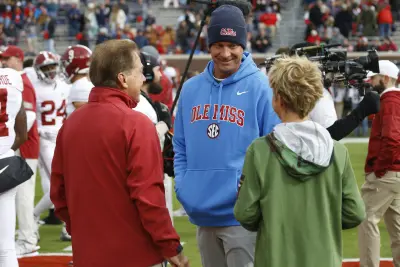
If you were to look at an infographic of a map of the highest paid public employee in each state in the United States, I am willing to bet 90% or more are a person who blows a whistle for a living and either coaches football or basketball.
Winning has always been paramount in college athletics. Schools view having an uber-successful program as part of a marketing wing to attract more and the best students to their school. The economic impact for schools in this area is extremely lucrative, but this has now turned college programs into professional organizations.
Listen to Lane Kiffin talk next time at an Ole Miss press conference or another Nick Saban disciple Kirby Smart at a Georgia press conference and you hear the Saban buzz word of “organization.”
When these schools are paying coaches nearly $100 million, a 7-5 record doesn’t cut it, and the carry over effect rolls from the coaches. Players in college athletics are temporary, you may see them on the field for two or three seasons before they move on to their life’s work or make it in professional sports, in essence your constant as a fan is the coach.
Coaches have many cliches they like to rally around, one is “there is no ‘I’ in team.”
In this era, the ‘I’ in college football is the coach and no one personified this more than Deion Sanders first talk at Colorado.
As Sanders took over, his viral moment occurred when Sanders said, “We got a few positions already taken care of because I’m bringing my own luggage with me.”
Included in his luggage was Sanders’ son Shedeur who at the time was the starting quarterback at Sanders previous post at Jackson State.
Sanders continued to say, “I’m coming. And when I get there, it’s gonna be changed, so I want y’all to get ready to go ahead and jump in that portal and do whatever you’re gonna get because the more of you jump into (the portal), the more room you make because we bring kids that are smart, tough.”
The momentum of Sanders has led to successful transfer of defensive back Travis Hunter and flipped Miami Hurricanes commit five-star defensive back Cormani McClain to Colorado.
What will be overlooked are the players who were committed to the program, but don’t fit Sanders narrative, according to The Athletic as many as 13 players have had their scholarships rescinded by Sanders.
Notably three-star Carson Mott explained how he learned he lost his scholarship to Colorado, “It was a huge mess,” said Mott, who is ranked 974th nationally and 92nd at his position, according to 247 Sports. “I actually never got contacted by Deion or any of his new staff. I got called. They told me that coach Deion didn’t want to honor my commitment and hung up the phone.”
Tapping Into the Brand
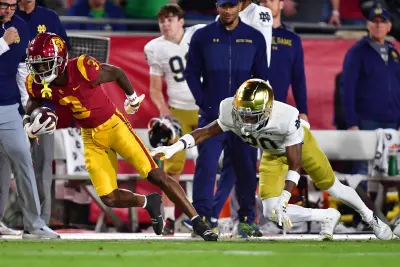
One of the biggest side effects from the social media revolution has been the exponential rise of individual branding.
Originally, platforms like MySpace and Facebook were just a place where people put random opinions, pictures of their Saturday night or their pets, and just a place to connect or reconnect with friends.
What it has become is a primary vehicle for individual branding. Young athletes are very much aware of the power of social media and how that could impact their brands or future brands, they know how to leverage it to get followers and create extreme value for themselves.
This has moved over to college athletics as in the last decade as the transformation seen in collegiate athletics hasn’t been this seismic since the Civil Rights/Title IX era.
In the last decade, the combination of the explosion in social media, the rise of the transfer portal, which went into effect in 2018, and then the changes in NIL laws that went into effect in 2021, has created a sport that cannot cope with the rate of change. College football is used to things moving at a glacial pace. The recent acceleration to hyper speed where colleges and universities along the with the NCAA is reacting instead of being proactive is a problem.
Both the transfer portal and NIL have added complexities to college football.
Pitt head coach Pat Narduzzi is championing a cause to create anti-tampering rules in NCAA. Narduzzi following his 2021 ACC Championship lost Biletnikoff award winning wide receiver Jordan Addison to Southern California.
Narduzzi said in the Post-Gazette, “Transferring is one thing. But the NCAA has to do something about tampering, because tampering is certainly happening in a big way. By players or coaches, it can’t happen. It’s happening a lot, and it’s not good.”
As the 2022 season came to a close, Narduzzi went on Pittsburgh’s 93.7 The Fan and dropped the allegation that North Carolina quarterback Drake Maye was approached by some schools and was offered nearly $5 million to transfer.
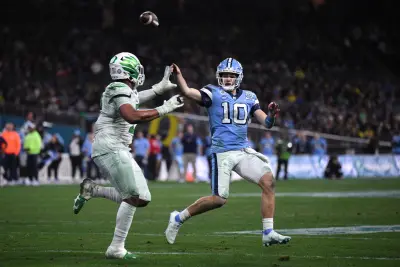
If you thought it was a witch hunt or fake, North Carolina head coach Mack Brown didn’t deny it, “I can’t say [which teams are talking to Maye],” Brown told reporters. “Don’t ask Drake. He’s a young guy, and it’s uncomfortable for him. You know who they are. Just look at all the ones that are getting the top recruits. They’re the ones paying all the top money. You can figure that out. Take two of those 10, and you’re right. And there’s probably more than the two that I know of.”
Brown described the illegal activities are conducted by agents who are connected with schools and leverage social media to connect with athletes. Most agents attempt to lure kids to the transfer portal during open periods and the bait now is leveraging NIL money.
When the United States Supreme Court heard the case Alston vs. NCAA involving a collegiate athlete’s ability to be compensated, most viewed the court’s decision as setting the stage for further legal challenges to rules limiting athlete compensation. Shortly following the high court’s decision and with many states now legalizing NIL for collegiate athletes, the NCAA on July 1, 2021 legalized NIL and the mayhem began.
The intent of name, image, and likeness compensation was for players like a Tim Tebow at Florida seeing a stadium full of No. 15 jerseys, his image plastered on everything imaginable to now receive compensation for it.
Instead, it became a recruiting tool, since there cannot be restrictions on what someone can earn, and collectives were formed. These collectives essentially speculate on what the earnings potential of an elite recruit and say you can earn an amount of money.
When you look at the Jaden Rashada situation, this had to have happened when you begin to look at the fallout between Rashada and Florida. He was never interested in being a Gator, that was never important to him, it was the money and when that couldn’t be delivered we saw it all unfold on public display.
A similar display occurred when you look at the disarray that was the 2022 Texas A&M season where several high profile recruits from their historic Class of 2022 including Denver Harris, Smoke Bouie, and Chris Marshall have now transferred.
None embraced being an Aggie. It was NIL money that was the deciding factor, and when losses began to stack, the money wasn’t worth it.
The NCAA is now in a situation where it must create rules to prevent further situations like Rashada’s or even those with Texas A&M. Rashada’s case is a demonstrative example of how broken the current collegiate athlete model is.
It will most likely need centralized legislation from the United States Congress to keep an even playing field across the country because a decentralized model will further the divide in collegiate athletics.
Conclusion
I want to unequivocally say college football will survive this tumultuous and turbulent period. History has shown us that college football has the perseverance in their DNA to overcome major obstacles.
The bigger question is what is the price for surviving and how long will it take to smooth out the turbulent times. The difference between now and what college football faced in its over 150 years in existence is this era it is systemic issues from top to bottom and there is no centralizing forcing function strong enough to keep balance together.
When you look at the conferences, there is a growing divide between the SEC, Big Ten and the other three Power 5 conferences. When media contracts begin to expire, when will the big two begin to poach at jewels in each of these conferences.
The bigger question is what happens to the leftovers? What happens to the middle powers?
Coaches continue to push the limits of the rules and winning at all costs is in play. The proverb “there is no honor among thieves” is apropos to college football coaches, it is almost who is the best at stealing from each other, who has the deepest state of rogue agents to recruit, the rewards of winning best is extremely lucrative to the tune of nine figures.
The interaction between coaches, athletes, and players will need to be figured out. While most schools say there is a separation between coaches and collectives, you cannot be naive enough to believe that a major college football coach doesn’t have a pulse of what is going on with the collective.
No time before in college football history has the collegiate athlete been afforded with great power.
In Stan Lee’s Spiderman series, Uncle Ben would tell Peter Parker (Spiderman), “with great power comes great responsibility.” With the accumulation of responsibility, power, influence, and now money in the position of the collegiate athlete, they collectively now have to figure how they will benefit the athletic community as a whole or benefit themselves individually at the expense of others.
If the collegiate athletes govern themselves accordingly with the transfer portal and NIL collectives it will continue to be a fruit bearing experience for years to come, but continued exploitation will restrict these new freedoms they enjoy.
This ultimate failure and true legacy of outgoing NCAA president Mark Emmert, who leaves office in June 2023, was his inability to get the NCAA to adjust with the times, to unify its member institutions, and create stability at the highest of levels.
One of Emmert’s failed themes he continued a tradition of stubborn NCAA presidents who simply failed to adjust with the times. History has shown every time the NCAA digs into its stubborn ways and doesn’t attempt to unify, it loses, and loses big.
For once, maybe everyone in the room needs to put their guards down and cooperate together starting to put the pieces back together because individuals cannot continue to have multiple views to fix this, it has to be a unified view and finding true leadership with that vision will be key with the constant evolution of collegiate athletics to truly fix everything.
